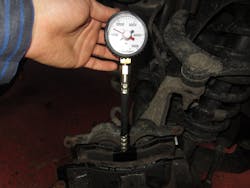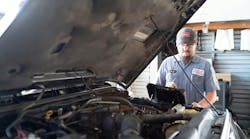Brakes, schmakes. Easy to diagnose and fix, right? Well, this 2010 Ford F150 almost ate my lunch and some cash out of my wallet too.
You might have noticed that factory brake pads these days tend to last for a long time. So, at 80,000 miles, this particular F150 finally needed its first set of front brakes.
We replaced everything with Ford Motorcraft parts and the job had no complications. The slides were cleaned and lubricated, the piston of the caliper pushed in fine and we even did a bleed on the brakes.
After a test drive, I noticed that the zinc coating's wear on the driver side was totally different than the passenger's side. Piquing my interest, I broke out my thermal imager and noticed that the temperature on the driver's side was about 100 degrees F warmer.
Next oil change, we inspected the brakes and, lo and behold, the brake pads were wearing away at an accelerated rate in the outside pad on the driver's side. No one stocked calipers for the vehicle so we got a set from the dealer and put them on.
Another oil change later, the problem was still there.
Being that I send my alignments to the Ford dealer, I asked them what they thought. The shop foreman told me that brake hoses were a pattern failure.
Now, that's a bad way to diagnose a car. However, we took our Disc Brake System Analyzer, No. 7884 from IPA, removed the brake pads and tested both sides. After replacing the brake hose on the driver's side, we still had a much smaller braking pressure on the passenger side (as you can see in the pictures).
What? The driver side runs hotter, it wears sooner and it has a new hose and caliper. Did we need a new master cylinder or ABS unit?
No. Another brake hose on the passenger side did the trick.
Why? The brakes were weak on the passenger side because of the defective brake hose, so the effort used to make the passenger side stop would, at the same time, have the driver's side apply too much pressure. So, the passenger side brake hose was making the driver's side brake pads wear unevenly.
After the new brake hose, both sides had a peak pressure of 1,900 psi. We put a new set of Ford brake pads on at no charge to the customer and that was it.
We couldn't prove it without the Disc Brake System Analyzer. The right tool and a little critical thinking helped solve this invisible braking problem.


